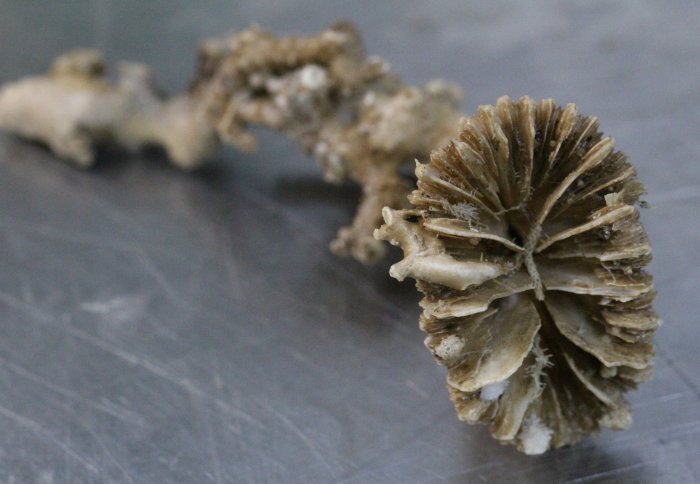Coral fossils reveal how changing wind patterns affect ocean circulation and CO2

A coral fossil used in the study. Credit: Andrew Margolin
Coral skeletons from the Southern Ocean have revealed how changes in wind patterns affect worldwide ocean circulation and atmospheric CO2 levels.
The findings show that wind patterns have a larger impact on oceans than previously thought and could provide new insights into the future changes that could arise from global warming.

The Southern Ocean, which surrounds Antarctica, serves as a critical conveyor belt that mixes water from the Atlantic, Indian and Pacific oceans while also distributing heat, nutrients and carbon dioxide (CO2) around the Earth’s seas. This makes it a prime location in which to study changes in the world’s oceans and climate.
Now, an international team of researchers, including Imperial College London's Professor Tina van de Flierdt, have shown that the Southern Ocean is more sensitive than previously thought to the atmospheric wind patterns over the region.
They did this by studying the skeletons of fossil corals collected from the Drake Passage in the Southern Ocean.
The researchers published their results in the journal Proceedings of the National Academy of Sciences.
Skeletons of bygone eras
The composition of the Nd isotopes in the middle layer of the deep sea, where the cold-water corals lived, suddenly looked more like those found in the Pacific Ocean. This indicated that water masses from that region were infiltrating the Southern Ocean but not mixing as one might expect Professor Tina van de Flierdt Department of Earth Science and Engineering
As the Southern Ocean sees a mixture of the world’s ocean waters, the skeletons from the cold-water corals that live there can tell us about bygone ocean chemistry from around the globe. These calcium carbonate fossils retain trace elements over time that reveal clues about the ocean’s past.
For the current study, the research team, led by Dr Torben Struve from the University of Oldenburg, measured isotopes of the trace element neodymium (Nd) in the coral fossils to record changes in seawater compositions over time.
During the warm periods between ice ages, waters from the separate world oceans tend to be mixed well in the Drake Passage. It was surprising then when the researchers observed a distinctive change in Nd isotope composition around six to seven thousand years ago, when the Earth had already come out of its previous ice age.
Professor van de Flierdt, of Imperial's Department of Earth Science & Engineering, said: “We did not initially set out to focus on this time period of the Holocene (the last 12,000 years) so none of us expected to see anything - but all of a sudden there was this signal, and we had to work out what it all meant.”
“The composition of the Nd isotopes in the middle layer of the deep sea, where the cold-water corals lived, suddenly looked more like those found in the Pacific Ocean. This indicated that water masses from that region were infiltrating the Southern Ocean but not mixing as one might expect.“
Other studies have suggested that atmospheric CO2 levels plateaued during this period – findings that would be consistent with less water mixing upwards towards the surface, or ‘upwelling’, leaving more CO2 stored in the deeper layers of the ocean.
Putting the pieces together
One explanation for the signal, the researchers say, can be found in records of the Southern Hemisphere westerly winds shifting northwards to the edge of the Drake Passage.
Study co-author Dr David Wilson from UCL said: “When the winds shifted northwards, the wind forcing was reduced, and the Southern Ocean was no longer as well vertically mixed. These changes allowed this distinctive Pacific mixture to flow into the mid-depths of the Southern Ocean, to be recorded where the corals were living.”

The water masses from the Pacific Ocean are the oldest on the planet and have time to accumulate carbon as they travel first north into the Pacific and then back south into the Southern Ocean. Once the winds shifted back southward, mixing and upwelling caused CO2 to be released back into the atmosphere.
Our study suggests that the ocean circulation is more sensitive to changes in atmospheric wind patterns than we previously thought. Dr David Wilson UCL
Dr Wilson added: “Our study suggests that the ocean circulation is more sensitive to changes in atmospheric wind patterns than we previously thought. People sometimes think about climate change as something happening on a global scale, but actually, if the oceans are this sensitive to wind changes, we need to take a much closer look at how climate affects ocean dynamics.”
One proposed effect of current global warming is a shifting of the winds in the Southern Hemisphere further southwards. According to the study, this would not only result in more CO2 being released from the deep ocean into the atmosphere; it would also increase ocean mixing and upwelling of these waters onto the shelves of West Antarctica - something that could subsequently contribute to melting of glaciers.
Next, the researchers will analyse coral skeletons from different locations in the Southern Ocean to explore how the ocean changed during warming at the end of the last ice age.
This study was funded by Imperial's Grantham Institute; the Leverhulme Trust, and the Natural Environment Research Council.
“Middle Holocene expansion of Pacific Deep Water into the Southern Ocean” by Torben Struve, David J. Wilson, Tina van de Flierdt, Naomi Pratt, and Kirsty C. Crocket, published 14 January 2020 in Proceedings of the National Academy of Sciences.
Article supporters
Article text (excluding photos or graphics) © Imperial College London.
Photos and graphics subject to third party copyright used with permission or © Imperial College London.
Reporter
Press Office
Communications and Public Affairs
- Email: press.office@imperial.ac.uk
